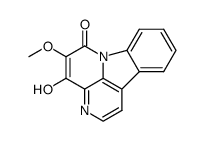101219-61-8
| Name | 4-hydroxy-5-methoxy-canthin-6-one |
|---|---|
| Synonyms |
5-methoxy-4-hydroxycanthin-6-one
picrasidine Q 4-Hydroxy-5-methoxy-indolo[3,2,1-de][1,5]naphthyridin-6-one 4-hydroxy-5-methoxycanthin-6-one |
| Description | Picrasidine Q, an alkaloid component extracted from Angelica keiskei species, has the capacity of anti-cell transformation and anti-cancer. Picrasidine Q induces cell apoptosis and G1 phase arrest in human esophageal cancer cell lines, and directly inhibits FGFR2 kinase activity[1]. |
|---|---|
| Related Catalog | |
| Target |
FGFR2 |
| In Vitro | Picrasidine Q (0~60 μM; 3 hours; ESCC cells) suppresses downstream signaling of FGFR2 in ESCC cells[1]. Picrasidine Q (0~60 μM; 48 and 72 hours; ESCC cells) induces cell cycle arrest and apoptosis[1]. Picrasidine Q (0~60 μM; 24~72 hours; ESCC cells) suppresses the growth of ESCC cells[1]. Picrasidine Q (0~60 μM; 30 minutes; JB6Cl41 cells) inhibits proliferation by inhibition of G1/S cell cycle transition[1]. Picrasidine Q (12.5, 25 or 50 μM) can inhibit the FGFR2 kinase activity in a dose-dependent manner[1]. Western Blot Analysis[1] Cell Line: ESCC cells Concentration: 0~60 μM Incubation Time: 3 hours Result: Suppressed downstream signaling of FGFR2 in ESCC cells. Apoptosis Analysis[1] Cell Line: ESCC cells Concentration: 0~60 μM Incubation Time: 48 and 72 hours Result: Induced cell cycle arrest and apoptosis. Cell Cytotoxicity Assay[1] Cell Line: ESCC cells Concentration: 0~60 μM Incubation Time: 24~72 hours Result: Suppressed the growth of ESCC cells. Cell Cycle Analysis[1] Cell Line: JB6Cl41 cells Concentration: 0~60 μM Incubation Time: 30 minutes Result: Inhibited proliferation by inhibition of G1/S cell cycle transition. |
| References |
| Molecular Formula | C15H10N2O3 |
|---|---|
| Molecular Weight | 266.25200 |
| Exact Mass | 266.06900 |
| PSA | 63.83000 |
| LogP | 2.15290 |

